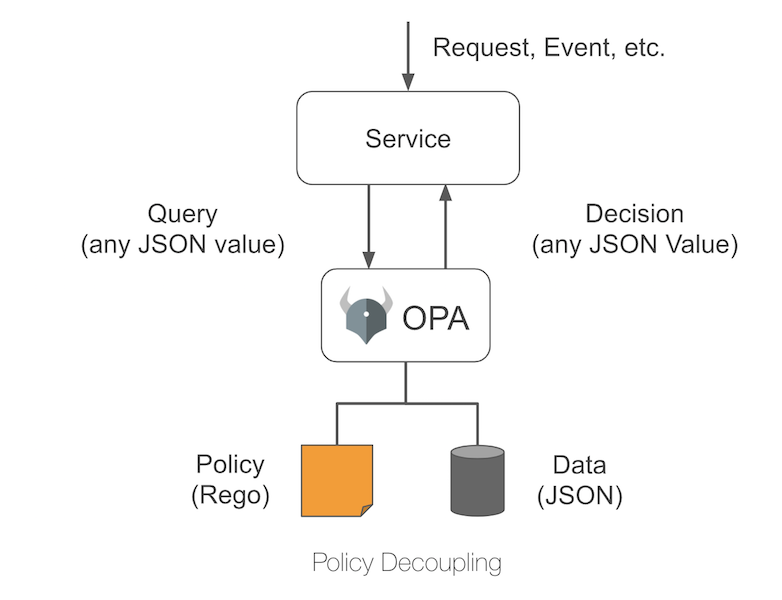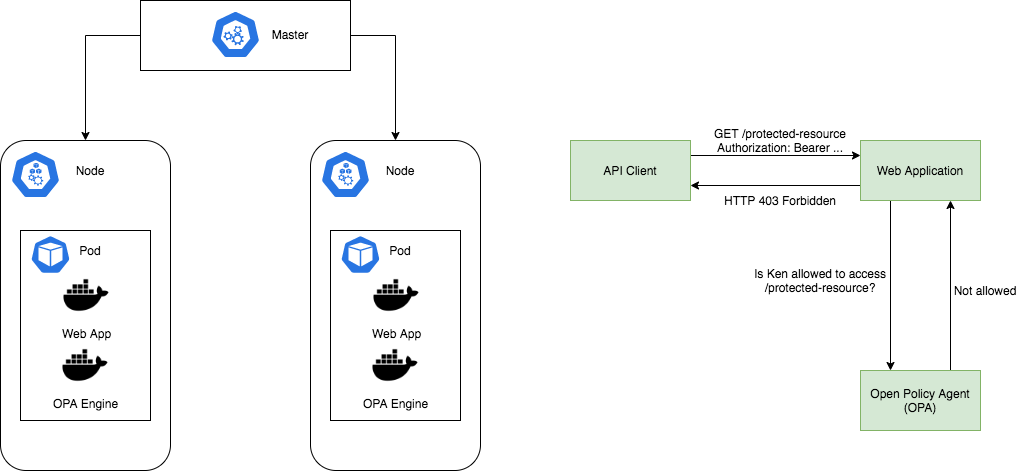API Authorization using Open Policy Agent (OPA) as a Sidecar Container
Using Open Policy Agent as a Sidecar container for REST Endpoint Authorization
Problem Statement
In today’s cloud native world, authorization and policies are more complex than ever. In a typical enterprise that has been using RBAC (Role Based Access Control) traditionally, the policy management becomes a nightmare because the need for creation of new users, roles, controls keeps growing based on everyday’s needs. Besides, enforcing these mammoth set of rules or policies to secure huge monolithic application makes it even more harder to manage and maintain.
There are organizations where policies are managed using Excel files or Word/PDF documents, and then implemented at the ground level. This leads to opportunities to make errors, making testing the policy changes really difficult or not possible, and rolling out new changes is extremely cumbersome.
OPA is a practical solution to solve these problems, especially for a cloud native world where the industry is moving to.
Overview of OPA
Key Features
-
Open Source(backed by CNCF):OPA is an `open source`, `general-purpose policy engine (of the CNCF)` that unifies policy enforcement across the stack. OPA provides a high-level declarative language that let’s you specify policy as code and simple APIs to offload policy decision-making from your software. You can use OPA to enforce policies in microservices, Kubernetes admission control, CI/CD pipelines, API gateways, and more.
-
Policy Engine with
Policies as first-class citizens:OPA treats `Policies as First Class Citizens`. Policies have their own lifecycle and toolset in OPA, which means you can manage policies on their own. This allows decoupling the applications/infrastructure using the policies from the policy management itself.
-
Policies can be
Test-Driven:OPA supports testing policies in isolation, which makes it more robust and scalable. In a distributed architecture world, this allows to gain more confidence by integrating the testing, and deployment process via a CI/CD pipeline.
-
OPA is
context-awareand decides based on the current context of the input, data and policy rules.
It means that the policy decision making uses the current context information to make the decisions. An Administrator can modify policies based on real world current situations, and OPA would take that into consideration right away.
At the outset, there are two aspects to security policy enforcement.
Policy Enforcement- This is the responsibility of the application to enforce the decisions of the policy evaluation outcomes.Policy Decision Making- This is the responsibility of the OPA Engine based on the data, input and policies available.
OPA simplies this by decoupling the maintaince of policies, providing access to decision making endpoints using structured data, and enforcement. When your software needs to make policy decisions it queries OPA and supplies structured data (e.g., JSON) as input. OPA accepts arbitrary structured data as input.
How does this help Developer Productivity?
Developers need not worry about designing the security access controls beforehand. Since the policies and decision making is decoupled, and uses the current context in time, OPA allows the developers to focus on building the software, and parallely or later on makes changes to the authorization policies, without affecting the application.
Since OPA policies can be test-driven, it makes it easier to decouple the application development from the Security policies development.

How is a decision made by the OPA Engine?
The OPA decision making process involves three pieces of information namely:
Data- The supporting data(in JSON) that OPA would need to make a decision. Eg: a list of ACLs with Users, Roles and Permissions to determine the access decision of a current user.Input- The request(in JSON) to OPA to determine a decision. Eg: Is a user Ken allowed access to a resource?Policy- A policy statement which specifies the logic to compute the decision using the input and data. Written in a specific language calledRego
Practical Example - Secure REST Endpoints using OPA
The codebase for the below example is available here
The steps below outline the implementation guidelines for a sample architecture, wherein we will secure two REST Endpoints and implement Authorization using OPA deployed as a Sidecar in a Kubernetes Pod.
For simplicity, the deployment architecture shows a simple Master connected with 2 worker nodes to form a cluster.

Web application setup
I used Spring Boot with Spring Security to expose two REST Endpoints /hello and /bye. Both the endpoints are protected by Basic Authentication using an in-memory authentication mechanism.
Note: Authentication is not really the focus of this example. The goal here is to demonstrate the authorization decision making using the login roles.
Assuming that you are familiar with basic Spring Boot setup, if not please use the Spring Initializer to bootstrap a basic Spring Boot project with Web dependency.
The two REST endpoints are simply as follows:
@GetMapping("/hello")
public String sayHello() {
return "Hello World";
}
@GetMapping("/bye")
public String sayBye() {
return "Bye";
}
For a basic Spring Security setup, please refer to the sample code below. Please do not hardcode credentials in a real environment.
WebSecurityConfiguration.java
@Configuration
@EnableWebSecurity
public class WebSecurityConfiguration extends WebSecurityConfigurerAdapter {
@Value("${opa.auth.url}")
private String opaAuthURL;
@Autowired
private AuthenticationEntryPoint authEntryPoint;
@Autowired
public void configureGlobal(AuthenticationManagerBuilder auth) throws Exception {
auth.inMemoryAuthentication()
.withUser("john123").password(passwordEncoder().encode("password")).roles("USER")
.and()
.withUser("admin123").password(passwordEncoder().encode("admin")).roles("ADMIN");
}
@Bean
public PasswordEncoder passwordEncoder() {
return new BCryptPasswordEncoder();
}
@Override
protected void configure(HttpSecurity http) throws Exception {
http.csrf().disable().authorizeRequests()
.accessDecisionManager(accessDecisionManager())
.anyRequest().authenticated().and().httpBasic();
}
@Bean
public AccessDecisionManager accessDecisionManager() {
List<AccessDecisionVoter<? extends Object>> decisionVoters = Arrays
.asList(new OPAVoter(opaAuthURL));
return new UnanimousBased(decisionVoters);
}
}
AuthenticationEntryPoint.java
@Component
public class AuthenticationEntryPoint extends BasicAuthenticationEntryPoint {
@Override
public void commence(HttpServletRequest request, HttpServletResponse response, AuthenticationException authEx)
throws IOException {
response.addHeader("WWW-Authenticate", "Basic realm=" +getRealmName());
response.setStatus(HttpServletResponse.SC_UNAUTHORIZED);
PrintWriter writer = response.getWriter();
writer.println("HTTP Status 401 - " + authEx.getMessage());
}
@Override
public void afterPropertiesSet() {
setRealmName("DeveloperStack");
super.afterPropertiesSet();
}
}
Note: The important thing to note here is that OPA exposes REST endpoints to allow invocations for decision making. To instruct Spring Security to interact with OPA, we create a
bean for AccessDecisionManager and register it. The AccessDecisionManager is a custom code that takes care of interaction with OPA. Sample code is below.
OPAVoter.java
public class OPAVoter implements AccessDecisionVoter<Object> {
private String opaAuthURL;
private RestTemplate restTemplate;
public OPAVoter(String opaAuthURL) {
this.opaAuthURL = opaAuthURL;
this.restTemplate = new RestTemplate();
}
@Override
public boolean supports(ConfigAttribute attribute) {
return true;
}
@Override
public boolean supports(Class<?> clazz) {
return true;
}
@Override
public int vote(Authentication authentication, Object obj, Collection<ConfigAttribute> attributes) {
if (!(obj instanceof FilterInvocation)) {
return ACCESS_ABSTAIN;
}
FilterInvocation filter = (FilterInvocation) obj;
Map<String, String> headers = new HashMap<String, String>();
for (Enumeration<String> headerNames = filter.getRequest().getHeaderNames(); headerNames.hasMoreElements();) {
String header = headerNames.nextElement();
headers.put(header, filter.getRequest().getHeader(header));
}
String[] path = filter.getRequest().getRequestURI().replaceAll("^/|/$", "").split("/");
Map<String, Object> input = new HashMap<String, Object>();
input.put("roles", authentication.getAuthorities());
input.put("method", filter.getRequest().getMethod());
input.put("path", path);
HttpEntity<?> request = new HttpEntity<>(new OPADataRequest(input));
OPADataResponse response = restTemplate.postForObject(this.opaAuthURL, request, OPADataResponse.class);
if (!response.getResult()) {
return ACCESS_DENIED;
}
return ACCESS_GRANTED;
}
}
OPADataRequest.java
public class OPADataRequest {
Map<String, Object> input;
public OPADataRequest(Map<String, Object> input) {
this.input = input;
}
public Map<String, Object> getInput() {
return this.input;
}
}
OPADataResponse.java
public class OPADataResponse {
private boolean result;
public OPADataResponse() {
}
public boolean getResult() {
return this.result;
}
public void setResult(boolean result) {
this.result = result;
}
}
I have a pipeline that builds the application, creates the Docker image and pushes to the Docker Registry as parameswaranvv/opa-web-demo:latest.
Dockerfile
FROM openjdk:8-jdk-alpine
RUN addgroup -S spring && adduser -S spring -G spring
USER spring:spring
ARG DEPENDENCY=build/dependency
COPY ${DEPENDENCY}/BOOT-INF/lib /app/lib
COPY ${DEPENDENCY}/META-INF /app/META-INF
COPY ${DEPENDENCY}/BOOT-INF/classes /app
ENTRYPOINT ["java","-cp","app:app/lib/*","com.example.opawebdemo.OpaWebDemoApplication"]
Defining OPA Policies
OPA uses Rego for defining Policies. For this example, since we have two endpoints, we will implement rules to allow access as follows:
/helloendpoint is allowed for logged in users withROLE_USERrole.
allow {
input.method == "GET"
input.path = ["hello"]
is_user
}
# user is allowed if he has a user role
is_user {
# for some `i`...
some i
input.roles[i].authority == "ROLE_USER"
}
/byeendpoint is allowed for logged in users withROLE_ADMINrole.
allow {
input.method == "GET"
input.path = ["bye"]
is_admin
}
# user is allowed if he has a admin role
is_admin {
# for some `i`...
some i
input.roles[i].authority == "ROLE_ADMIN"
}
Putting this together, we have
opaweb-policy.rego
package opaweb.authz
default allow = false
allow {
input.method == "GET"
input.path = ["hello"]
is_user
}
allow {
input.method == "GET"
input.path = ["bye"]
is_admin
}
# user is allowed if he has a user role
is_user {
# for some `i`...
some i
input.roles[i].authority == "ROLE_USER"
}
# user is allowed if he has a admin role
is_admin {
# for some `i`...
some i
input.roles[i].authority == "ROLE_ADMIN"
}
Testing our defined policies
OPA allows us to test the policies in isolation, without the real need for an application. This allows us to scale and deploy policies as needed in a distributed fashion. This is also a fantastic feature of OPA that allows us to deliver Policy changes in a CI/CD manner.
opaweb-policy-test.rego
package opaweb.authz
test_hello_allowed_for_user {
allow with input as {"path": ["hello"], "method": "GET", "roles": [{"authority": "ROLE_USER"}]}
}
test_hello_denied_for_others {
not allow with input as {"path": ["hello"], "method": "GET", "roles": [{"authority": "ROLE_ADMIN"}]}
not allow with input as {"path": ["hello"], "method": "GET", "roles": [{"authority": "ROLE_ANONYMOUS"}]}
}
test_bye_allowed_for_admin {
allow with input as {"path": ["bye"], "method": "GET", "roles": [{"authority": "ROLE_ADMIN"}]}
}
test_bye_denied_for_others {
not allow with input as {"path": ["bye"], "method": "GET", "roles": [{"authority": "ROLE_USER"}]}
not allow with input as {"path": ["bye"], "method": "GET", "roles": [{"authority": "ROLE_ANONYMOUS"}]}
}
To run the tests, just do
$ ./opa test . --verbose
data.opaweb.authz.test_hello_allowed_for_user: PASS (623.171µs)
data.opaweb.authz.test_hello_denied_for_others: PASS (212.274µs)
data.opaweb.authz.test_bye_allowed_for_admin: PASS (184.635µs)
data.opaweb.authz.test_bye_denied_for_others: PASS (274.028µs)
--------------------------------------------------------------------------------
PASS: 4/4
Run locally and check
-
Instructions to run OPA locally
- Refer here for instructions on downloading OPA to your machine.
- Alternative, use Docker to spin it up instantly.
$ docker run -p 8181:8181 openpolicyagent/opa run --server --log-level debug -
Register the Policy definition in the OPA server using the available REST endpoint.
$ curl --location --request PUT 'localhost:8181/v1/policies/opaweb/authz' \ --header 'Content-Type: text/plain' \ --data-binary @opaweb-policy.rego -
Run the Spring Boot application. Assuming the app is exposed on port
8080, you can try invoking the following endpoints to received a HTTP OK response with the appropriate response body.:$ curl -kv http://localhost:8080/hello --header 'Authorization: Basic am9objEyMzpwYXNzd29yZA=='$ curl -kv http://localhost:8080/bye --header 'Authorization: Basic YWRtaW4xMjM6YWRtaW4='
Deploying in a Kubernetes Environment
For the above example, I created a Deployment definition yaml that I used to deploy in my Kubernetes cluster. The deployment specifies a Pod containing two containers:
- the webapp
- OPA server
But, how do we provide the policies to the server? Calling REST endpoints at startup, in a Production grade environment is not really recommended. Instead, we can create ConfigMaps or Secrets with our Policy files, and mount them as volumes in the OPA Container.
configmap.yml
$ kubectl create configmap opademo-policy --from-file=opaweb-policy.rego
deployment.yml
apiVersion: apps/v1
kind: Deployment
metadata:
name: opademo
labels:
app: opademo
spec:
replicas: 3
selector:
matchLabels:
app: opademo
template:
metadata:
labels:
app: opademo
name: opademo
spec:
containers:
- name: webapp
image: parameswaranvv/opa-web-demo:latest
ports:
- name: http
containerPort: 8080
env:
- name: opa.auth.url
value: http://localhost:8181/v1/data/opaweb/authz/allow
- name: opa
image: openpolicyagent/opa:latest
ports:
- name: http
containerPort: 8181
args:
- "run"
- "--ignore=.*" # exclude hidden dirs created by Kubernetes
- "--server"
- "/policies"
volumeMounts:
- readOnly: true
mountPath: /policies
name: opademo-policy
livenessProbe:
httpGet:
scheme: HTTP # assumes OPA listens on localhost:8181
port: 8181
initialDelaySeconds: 5 # tune these periods for your environemnt
periodSeconds: 5
readinessProbe:
httpGet:
path: /health?bundle=true # Include bundle activation in readiness
scheme: HTTP
port: 8181
initialDelaySeconds: 5
periodSeconds: 5
volumes:
- name: opademo-policy
configMap:
name: opademo-policy
We then go on to expose a Service for our webapp, so that we can access it via the Service.
service.yml
apiVersion: v1
kind: Service
metadata:
name: opa-demo
spec:
selector:
app: opademo
ports:
- protocol: TCP
port: 8080
targetPort: 8080
Done!! You can test the webapp now using your Service IP address and reuse the same CURL commands from above.